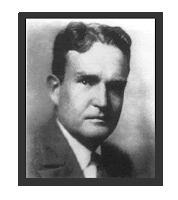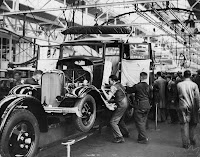Tuesday, March 2, 2010
Politics and Culture in the Jazz Age
I. Politics and Culture in the Jazz Age
A. Minimize federal government intervention in the economy
1. Treasury Secretary Mellon – persuaded Congress to halve the income tax for the top bracket of taxpayers, and drastically lower the inheritance tax (1926)
2. Federal government and railroads – in 1920, the federal government returned control of the railroads to private hands
II. Presidential politics in the 1920s
A. Warren G. Harding – last, and least, of the Ohio presidents; former newspaper editor from Marion, filled appointments with cronies from Ohio, known as the “Ohio Gang,” who looked to line their own pockets
1. “Normalcy” – (demonstrates the Bush is not our first English-challenged President; Harding in fact made up this word) Harding’s term for returning the country to normal—conditions back to some idyllic period before the class and race strife brought on by the unprecedented US involvement in a foreign war.
2. Teapot Dome Scandal – Secretary of Interior Albert B. Fall, allowed private companies to drill at an oil reserve called Teapot Dome in>Wyoming, secretly, after receiving “loans” from oil company executives.
3. Harding dies in office – after contracting food poisoning on the west coast. He had a hero’s funeral, but almost immediately afterward the stench of scandal from his administration lingered on over much of the next decade.
B. Calvin Coolidge – the solidity of Coolidge, and his personal lack of color, allowed him to distance himself from the scandals of the Harding administration, which he was part of.
1. 1924 Election – Democratic party badly divided; Southern Democrats continued to support Prohibition, and refused to denounce the anti-Catholic and anti-Jewish KKK, while the northern branch of the party wanted former NYC mayor, NY governor, and Catholic Al Smith; after a record 103 ballots, compromise candidate Wall Street lawyer John Davis selected.
a. “Young Bob” LaFollette and the Progressive Party – painted as a dangerous radical by Coolidge campaign.
b. Proclaimed the “Greatest issue is the control of government and industry by monopoly capital”
c. Nationalization of railroads and water power
d. Ban labor injunctions
e. Increase aid for farmers
f. Restructure tax system to benefit working people
g. LaFollette was able to poll one sixth of the popular vote
h. Coolidge as a reflection on dominant ideology
i. Bruce Barton and The Man Nobody Knows – ad-man Barton portrayed Jesus Christ as a successful business man (which he considered a compliment). This provided a way to reconcile new societal mores with America’s fundamentalist Protestant past.
j. New importance of consumption – the “first importance to his country is no longer that of a citizen but that of consumer. Consumption was a new necessity to maintain economic prosperity--but the ability to consume was unequally distributed.
k. Reaction – Sinclair Lewis, in his novel Babbitt, decried the standardization and routinization of everyday life; that nationally advertised brands became the standard of excellence merely because everybody had heard of it.
2. Coolidge era foreign policy – “in these days of competition . . . capital . . .and statecraft go hand and hand.”
a. Pax Americana – the creation of a new world order that would bring stability and allow for expansion of American capitalism.
3. Foreign policy “successes”
a. Negotiated end to the naval arms race; the UK and the US limited to 500,000 tons, Japan to 300,000—but Japan was only interested in maintaining a one-ocean navy).
b. Dawes Plan – reduced the reparations that Germany was required to pay; country at that time was suffering from runaway inflation.
4. Industrial foreign policy a. In 1929, eight US automobile manufacturers were running factories in foreign countries (including Ford in England; high tech companies of the time (GE, International Telephone and Telegraph, Western Electric) had created an international communications system.
5. Exploitation of under developed countries
a. Venezuelan oil
b. Chilean copper
c. Cuban Sugar
d. Central American fruit (Smedley Butler reminder)
C. Immigration policy – after years of anti-immigrant agitation, widespread restrictions on immigration are put in place.
1. 1924 Immigration (Johnson-Feed) Act – restricted total immigration to 165,000/year; also set quotas pegged to the 1890 federal census ethnic totals in a conscious attempt to exclude as many eastern and southern European peoples as possible (Italians had averaged over 200,000/year in 1900s, but were limited to less than 4,000 after 1924)
2. Barred immigration completely from people who were ineligible for citizenship (Asian Indians, Chinese, and Japanese) b. Did not restrict immigration from countries from the Western Hemisphere, so the migration of farm laborers (and industrial workers) fromMexico and laborers from French Canada continued unabated.
D.. Herbert Hoover – a competent administrator who became overwhelmed by circumstances, and who lacked the vision to overcome those circumstances.
1. 1928 Election a. Democratic Party – splits again over the Presidential candidate; this time the northern half of the country prevailed and Alfred Smith, the Catholic, was nominated (as was the former secretary of the Navy and governor of New York Franklin D. Roosevelt); his anti-Prohibition stance did not play well in Peoria, however—or anywhere else outside of the large metropolitan centers, and Smith suffered an overwhelming defeat; because of his stance on alcohol and this Catholicism, he could only carry the six Deep South States
.
III.Mass Culture
A. Radio – for the first time, a mass audience could experience an event at the same time. Although this was used as a technique to keep alive ethnic cultures (polka stations, foreign language programs, etc.), it also allowed others outside that culture to experience it; business side led to mass entertainment to sell products—which in turn contributed to the homogenization of culture.
B. Phonograph records – a way to maintain ethnic ties as well; but once a record was distributed, there was no way to limit who would consume it, which meant that there was a great deal of interaction between cultures, which in turn created a new culture (Caruso, Sophie Tucker “The Last of the Red Hot Mamas,” the Austin High Gang of ethnics who frequented the jazz clubs of Chicago’s South Side and helped to create the swing music of the 1930s, particularly one Benny Goodman)
C. Movies – 1920s were a boom time of the downtown movie palaces, which were paeans to consumer culture; as the star system became more refined, these actors became more and more used to sell products (cigarettes, automobiles, etc.)
D. Automobiles – by 1929, 50% of American families owned an automobile, and the industry directly employed 375,000 people—with millions more indirectly employed because of it.
1. Fordism – Ford’s contribution to the automotive industry was his drive to reduce the cost of the automobile, so that it would become more widely accessible to the general public; Ford accomplished this by increasing the number of specialized machines used to create parts for the automobile. This had two advantages: it decreased his reliance upon skilled workers, who could demand higher wages; and it allowed him to set a specific pace of manufacturing, rather than letting the workers set their own pace
a. Model T – extremely limited choice (it came with no options, and in one color—black), but this allowed Ford to perfect its manufacture—which in turn allowed Ford to drop the price of the automobile from $950 when it was introduced in 1909 to $290 at the height of its popularity in 1924
b. $5 a Day – the famous $5/day wage, instituted in 1914, was approached by few workers, but it helped limit the turnover of 300%; the higher overall wage also allowed workers to purchase the product that they were manufacturing.
c. Increased mobility – ownership of an automobile allowed many more people to move to the suburbs (or “into the country’); also created a greater demand for recreation—along with more workers employed in routinized labor.
2. Sloanism – named after the President of the General Motors Corporation, Alfred P. Sloan. Sloanism is in many ways the perfection of Fordism; automobiles were provided in a variety of styles (kind of), and a variety of price ranges, with advertising aimed at creating a want (or “need”) for a new replacement at regular intervals.
a. Creation of the General Motors Acceptance Corporation – GMAC created in order to provide financing for potential automobile purchasers who could not pay cash for an automobile.
b. Triumph of Sloanism – by 1927, falling sales of the Model T forces Ford to shut down production, and re-tool for the production of the Model A. In 1924, Ford had commanded 55% of the new car market.
c. Increased importance of advertising – used to help people differentiate between largely undifferentiated products; advertising allowed companies to manufacture desires in their customers.
E. African American Culture and Political Development in the North – the vitality and creativeness of African American culture first gets widespread recognition as more African Americans move north, and more white northerners come into contact with it.
1. Jazz – first comes north in the early 1920s—moved up the Mississippi from New Orleans to St. Louis, and then from St. Louis to Chicago; Louis Armstrong moved to Chicago from New Orleans, first with his Hot Five (which eventually grew into his Hot Seven).
2. Southside Chicago – the area around 43rd and State was the heart of the African American community in Chicago, the so-called Black Metropolis. It was here that a group of second generation ethnics from the west side Austin High School came to listen to the jazz bands that played the venues here, and by the late 1930s had transformed the sound into what we know as swing.
3. New York – NYC quickly became a Mecca for African American jazz players, who found gigs in the burgeoning African American neighborhood in the city known as Harlem
a. “Black and Tan Clubs” – clubs where “slumming” whites could come and listen to and dance to black combos, without having to be alarmed with having to mingle with too many African Americans, unless it was the wait staff or the musicians. The Cotton Club became the most famous of the clubs.
b. “Sweet” music and “hot” music – white dance bands toured the hinterlands playing “sweetened” versions of new “hot” jazz hits. Bands like the Paul Whiteman Orchestra, who would hire a few “hot” players (most notably Bix Biederbecke), but played mainly toned down versions of jazz music.
4. Reaction to Mass Culture
a. Prohibition – outlawed the manufacture, and legal drinking; led to the flowering of organized crime. By outlawing what had been acceptable, it grouped this behavior with other behavior that was looked down upon as well (secular music, dance, homosexuality) that then became tolerated in this developing underground society—and then more laws were passed to outlaw this behavior.
b. Rise of Fundamentalist Religion – reaction to increased urbanization, increased social contact with Catholics and Jews in urban settings. White southerners moving north also contributed to this. Billy Sunday and Aimee Semple McPherson
c. Rebirth of the KKK – became particularly active in northern cities (as well as much of the state government in Indiana; Catholics and Jews, and those who resisted enforcement of prohibition, became as much a target of intimidation in the North as African Americans during this time.
5. Scopes “Monkey Trial” – the so-called “Monkey Trial” personifies the tensions that were becoming apparent among white protestants in the country. In Dayton, TN, the ACLU convinced a teacher named John Scopes to violate recently passed creationist law; Clarence Darrow was the lawyer for the defense, and William Jennings Bryan was on prosecution team; Darrow called Bryan as an expert witness, and got him to admit to numerous embarrassing literal interpretations of the Bible—Bryan died soon afterward.











No comments:
Post a Comment